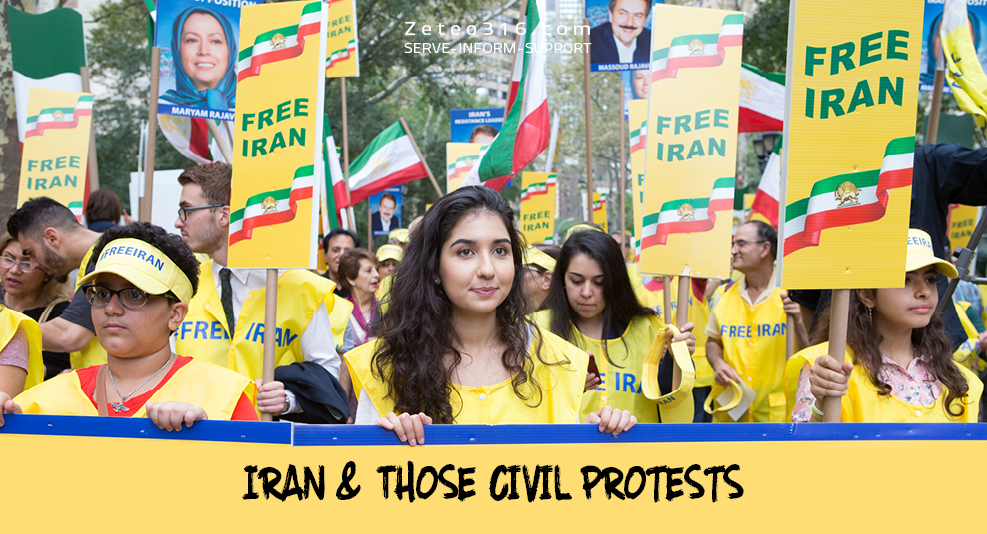What’s going on with Iran and those civil protests? The recent Iranian civil unrest has drawn some interesting predictions and analyses from the pundits. This is one of those frequent times I’d profit from input from Omega Letter founder Jack Kinsella.
One problem is that there are so many variables and twists and turns to this complicated Middle East scenario. The other problem is that I can’t access Jack. Hence there will be no assertive predictions from me!
If we’ve learned anything from the past ten years or so, it is to expect the unexpected. I’ve said this before: who would have expected a junior senator to appear out of nowhere and radically impact the US and the Middle East? And what about Donald Trump? My money certainly wouldn’t have been on him!
So what about those Iranian protests? In a nutshell, the basic reason for the unrest is the economy. It’s no secret that Iran has been channeling funds to Hezbollah and Hamas, rather than passing Obama-Iran-Nuclear-Deal benefits onto its people.
According to Joseph Klein:
The current protests are not led by students and the urban middle class, as was the case during the failed Green Movement in 2009. Nor are today’s protests about the legitimacy of a single presidential election, or a battle between so-called “reformers” and hardliners. These are populist protests, initially fueled by economic discontent amongst young people in rural areas, towns and small cities, who have come to despise the entire theocratic establishment.
Following the Iranian protests, several people (e.g., Michael Brown) have rightly noted that Christianity has been growing exponentially in that nation. In fact Back to Jerusalem’s Eugene Bach wrote a book (Jesus in Iran) which highlights this decades-old movement.
While there has been an underground movement of the Holy Spirit in Iran, I doubt this is significant to the current protests. Were these violent protests or did the regime respond in violence? Understandably, any information disseminated by the Iranian regime will be sanitized. Nevertheless, we ought to be careful in arriving at conclusions.
My next few thoughts will appear to be going off on a long tangent. But they’re somewhat relevant to the discussion. During a Q & A session (24:35 min mark), Theologian Sinclair Ferguson stated that the greatest threat to Christianity today was “Christianity” – even a greater threat than Islam.
Ferguson was taken to task by Islam-critic Robert Spencer. He scolded:
Ferguson is spreading a dangerous message and perpetuating a blindness and navel gazing within the Church. This reduction to irrelevance in the current day has caused the Church to lose numbers, “lose its salt,” and lose its compassion for victims of jihad terror. Worst of all is Ferguson’s implied message that the world’s problems are the fault of Christians.
I respect both gentlemen. Spencer is a recognized expert on Islam. Not a self-professing one, as Wiki pejoratively states. He has bravely warned about the (physical) dangers of Islam for years. But Sinclair Ferguson is correct in this instance.
Ferguson didn’t infer that the world’s problems are the fault of Christians. He understands the temporal-existential dangers of Islam. What he’s referring to is the False Christianity (false gospel) which permeates the West, and which leads to eternal damnation. The way we identify the false is to know the true.
I alluded to Chrislam in a previous article. The gospel is precise regarding salvation and there are biblical warnings about this (Gal 1:8-9; 2 Tim 4:1-4; Jam 3:1). Something resembling Christianity, yet preaching a false gospel, is far more dangerous to one’s eternal state than anything obviously opposed to it. That was Ferguson’s point.
We can see by the Iranian example (and many others) that Christianity can thrive under oppression – and often because of it. Erwin Lutzer’s The Cross in the Shadow of the Crescent is well worth reading on these issues.
One European expert believes Trump may be responsible for the Iranian demonstrations. As an example she cites Reagan and the fall of the Soviet Union. She suggests that the Iranian protests could lead to the downfall of the Islamic Republic. I’m not convinced.
While Iran’s economic problems won’t go away any time soon, the demonstrations will likely subside. (I’ve been wrong before). In and out of the Soviet Union example there were reformers helping Reagan’s initiative. What would replace the current Iranian regime today? The Saudis might well be happy with the current Iranian civil unrest. Yet if Turkey, Syria and Libya are any indication, we shouldn’t assume a change for the better.
Others have pointed to Putin’s concerns regarding Russian investments in the region in light of this unrest. Russia has already invested so much into the region that you might say it is hooked to it. Pun intended. Russia needs to stay committed to the region.
Considering all this, Iran is of particular interest to students of biblical eschatology. See the article: What role does Iran play in the end times?
John Haller delivers weekly presentations on issues relating to prophecy. One of these was aptly titled “Powder Keg.” It is recommended viewing. The Middle East is a dry powder keg threatening to explode any time. If and when that occurs, the ramifications will be global.
Are we hearing the footsteps of the Lord’s return?

